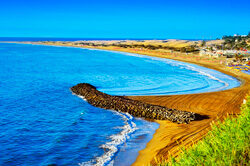Gran canaria tourist information.
 Gran Canaria is the third largest of the Canary Islands after Tenerife and Fuerteventura. Round as a ball, Gran Canaria is more than the sum of its famous beaches, where holidaymakers assume the horizontal position to lap up one of the world’s most-celebrated climates. Gran Canaria was “discovered” in 999AD, when the Granada-based navigator Ibn Farrukh landed and introduced the wonder plant aloe vera to its shores. However, before the Spanish arrived in the 15th century, the Canarii occupied the island. These Berber-descended people had no knowledge of shipbuilding, which has led historians to conclude they were exiled landlocked slaves.
Gran Canaria is the third largest of the Canary Islands after Tenerife and Fuerteventura. Round as a ball, Gran Canaria is more than the sum of its famous beaches, where holidaymakers assume the horizontal position to lap up one of the world’s most-celebrated climates. Gran Canaria was “discovered” in 999AD, when the Granada-based navigator Ibn Farrukh landed and introduced the wonder plant aloe vera to its shores. However, before the Spanish arrived in the 15th century, the Canarii occupied the island. These Berber-descended people had no knowledge of shipbuilding, which has led historians to conclude they were exiled landlocked slaves.
Gran Canaria has quite a range of landscapes as sandy desert in the south, lush forest in the rainier north, bleak arid mountains in the centre and the thriving cosmopolitan city of Las Palmas in the north east. The Dry South contrasts with the Green Pine Forests of the Mountainous interior and it is not unusual for there to be snow on the peaks while Holidaymakers are sunbathing on the beaches below.
Las palmas de Gran Canaria
Las Palmas was established by Juan Rejón, an Aragonese captain in the Castilian navy, on 24 June 1478. It has grown into the ninth-biggest Spanish city and the largest in the Canaries, with a population of around 400,000. It’s not hard to see why capital Las Palmas de Gran Canaria was named after the island’s palms. They are everywhere. The colonial architecture, shopping, bars and restaurants make this city well worth a visit. Also in Las Palmas is the 3km long Playa de Las Canteras, often described as one of the best urban beaches in Europe – and thanks to the protection of a barrier reef, it offers great bathing conditions for the whole family.